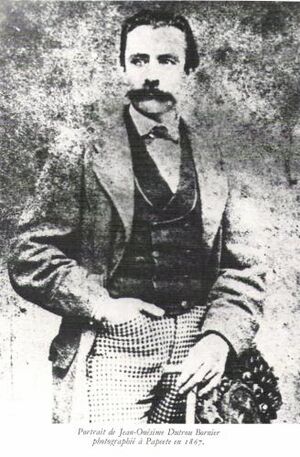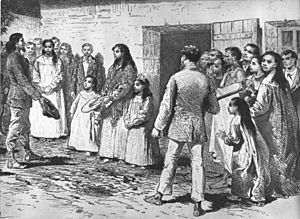Jean-Baptiste Dutrou-Bornier facts for kids

Jean-Baptiste Onésime Dutrou-Bornier (born November 19, 1834 – died August 6, 1876) was a French sailor. He moved to Easter Island in 1868. He bought a lot of land there and turned the island into a sheep farm. Many of the Rapa Nui people were moved from their homes during this time.
Contents
Early Life and Travels
Jean-Baptiste Dutrou-Bornier was an artillery officer. He fought in the Crimean War. By 1860, he became a skilled ship captain. He left his family in France.
In 1865, he bought part of a ship called the Tampico. He sailed to Peru. After some trouble, he was released with help from the French consul. Then, he sailed to Tahiti. There, he started finding workers from other islands in Polynesia. These workers were for coconut farms.
Arriving on Easter Island
In November 1866, Dutrou-Bornier took two missionaries to Easter Island. Their names were Kaspar Zumbohm and Theodore Escolan. He visited the island again in March 1867 to find more workers.
Later, he got into financial difficulties. He lost his share of the Tampico. He then got another yacht called the Aora'i. He arrived on Easter Island in April 1868. His yacht was burned there.
He made his home at Mataveri. He began buying land from the Rapanui people. In 1869, he married Koreto, a Rapanui woman. He tried to get France to make the island a protectorate. This would mean France would protect and control the island.
Dutrou-Bornier gathered a group of Rapanui people who supported him. He allowed them to return to their old beliefs. With weapons, he and his supporters controlled the island for several years. He acted as "governor." He even named Koreto as "Queen." However, this title was not officially recognized by the Rapanui people or by history experts.
Changes to Easter Island
Dutrou-Bornier wanted to turn Easter Island into a large sheep farm. He bought almost all the land on the island. The only part he did not buy was the missionaries' area near Hanga Roa. He moved hundreds of Rapanui people to Tahiti. They went to work for the people who supported him.
In 1871, the missionaries had disagreements with Dutrou-Bornier. They moved almost all the remaining Rapanui people to the Gambier islands. Only 171 Rapanui stayed on Easter Island. Most of those who stayed were older men. Six years later, only 111 people lived on Easter Island. Only 36 of them had children.
His Death
In 1876, Dutrou-Bornier was killed. This happened during an argument about a dress.
What He Left Behind
After Dutrou-Bornier's death, the population of Easter Island slowly grew again. But more than 97% of the people had died or left in less than ten years. This meant much of the island's culture and knowledge was lost.
His first wife in France was his legal heir. His second wife on the island briefly made their daughter Caroline "Queen." But neither of them kept much from his property. Even today, most of Easter Island is a ranch. It is controlled by people who do not live on the island. For over a century, real power on the island was often held by non-Rapanui people living at Mataveri.
Many shipwrecks had left the island with more wood than it had seen in a long time. Also, problems with Dutrou-Bornier's land deals caused difficulties for the island's history for many years.



